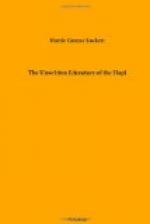“Shortly before sunrise, the bride, arrayed in her finery, performs the last act in the drama, called ‘going home.’ Up to this time the bride has remained in the house of her husband’s people. Wearing the large white blanket, picturesquely disposed over her head, and carrying the small blanket wrapped in the reed mat in her hands, she walks to her mother’s house ... and the long ceremony is over ... for in this land of women’s rights the husband must live with his wife’s relatives.”
[Footnote 34: Hough, Walter, Op. cit, p. 123.]
The bride may not appear at a public ceremonial dance until the following July, at the Kachina Farewell ceremony, when all the brides of the year turn out in their lovely wedding blankets and white leggings, the only time this blanket is ever worn after the wedding (during life), save one the naming ceremony of her first child.
It becomes her winding sheet when at death she wears it in her grave, then after four days, she takes it from her shoulders and uses it as a magic carpet when, having reached the edge of the Grand Canyon, she steps out upon her ceremonial blanket, and like a white cloud it descends with her to Maski, the underworld paradise of the Hopi.
Are the Hopi married in this way today? Most certainly. Figure 12 shows a Hopi girl who worked for the writer for three summers. She is a fine, intelligent girl, having gone more than halfway through high school before she returned to her home on Second Mesa to live. This is her wedding picture taken last year at the moment of her “going home,” after just such a wedding ceremonial as described above.
[Illustration: Figure 12.—A Hopi Bride.
—Photo by Colton.]
A letter from friends of the writer states that her baby is just now going through his natal ceremonies in the good old Hopi way. If the Snake Dance is continued till he grows up—it makes one shudder to think of it—he is in line to be a Snake priest!
=Burial=
Here we have the account of Goddard:[35] “When an adult dies, the nearest relatives by blood wash the head, tie a feather offering to the hair so that it will hang over the forehead, wrap the body in a good robe and carry it to one of the graveyards which are in the valleys near the mesas. The body is buried in a sitting position so that it faces east. This is done within a few hours after death has occurred. The third night, a bowl containing some food, a prayer-stick offering, and a feather and string, are carried to the grave. The string is placed so that it points from the grave to the west. The next morning, the fourth, the soul is supposed to rise from the grave and proceed in the direction indicated by the string, where it enters the ‘skeleton house.’ This is believed to be situated somewhere near the Canyon of the Colorado.”
[Footnote 35: Goddard, P.E., Op. cit.]
Any bodies of young children who have not yet been initiated into any fraternity are not buried in the ground, but in a crevice of rock somewhere near the mother’s home and covered with stones. A string is left hanging out, pointing to the home of the family. The spirit of the child is believed to return and to be re-born in the next child born in the family, or to linger about till the mother dies and then to go with her to the underworld.




